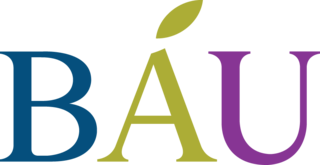
Gimpo is a city in Gyeonggi Province, South Korea. It borders Incheon, with which it shares the South Korean side of the Han River estuary, as well as Seoul and the lesser cities of Paju and Goyang. North Korea is across the Han River. The current mayor is Jeong Hayoung. The city's population of more than 300,000 is made up of more than 71,000 households.

Uiwang is a city in Gyeonggi Province, South Korea. It is one of many satellite cities that ring Seoul, making up the Seoul Capital Area. Its largest immediate urban neighbor is Anyang. The low peaks of the Gwangju Mountains shape the local landscape.

The Seoul Arts Center is an arts complex in Seocho District, Seoul, South Korea. It consists of five main buildings: the Opera House, with three auditoriums; the Music Hall, with two concert halls; the Hangaram Art Museum; the Hangaram Design Museum; and the Seoul Calligraphy Art Museum. The Opera House is built in a shape that resembles the traditional Korean bamboo hat called gat.

Insa-dong (Korean: 인사동) is a dong, or neighborhood, in Jongno District, Seoul, South Korea. Its main street is Insadong-gil, which is connected to a number of alleys that lead deeper into the district, with modern galleries and tea shops. Historically, it was the largest market for antiques and artwork in Korea.

Hongik University is a private university in Mapo, Seoul, South Korea. It was founded in 1946. The university also maintains a branch campus in Sejong City.

Sookmyung Women's University (Korean: 숙명여자대학교) is a private women's research university in Yongsan-gu, Seoul, South Korea. Founded in 1906, Sookmyung is Korea’s first royal private educational institution for women. Sookmyung is one of the world's largest female educational institutes. The university's name is derived from the Hanja characters of sook and Myung, which mean "elegant" and "bright" respectively.
Atta Kim is a South Korean photographer who has been active since the mid-1980s. He has exhibited his work internationally and was the first photographer chosen to represent South Korea in the São Paulo Biennial.

Artsonje Center is a private art museum in Seoul, Korea, located in Samcheong-dong, a neighborhood adjacent to known for its numerous art galleries, cafes, restaurants and boutiques. Founded in 1998, the museum introduces current and experimental contemporary art to the art world and public with its international exhibitions and educational programs.
The Han Sang Soo Embroidery Museum is an art museum specializing in Korean embroidery located in Gahoe-dong, Jongno-gu, central of Seoul, South Korea. It was established by Han Sang Soo, who holds a title as a jasujang, a profession recognized as an Important Intangible Cultural Property by the Cultural Heritage Administration of South Korea.
Horim Museum is a museum in Seoul, South Korea.

Ilmin Museum of Art is a private art museum of South Korea, located on Sejongno street in Jongno District, a central district of Seoul, known for exhibiting mainly Korean art. The museum was established and run by the Ilmin Cultural Foundation (일민문화재단), a non-profit organization founded in 1994 in memory of Kim Sang-man (1910–1994), former president of The Dong-A Ilbo, one of the major newspaper companies of South Korea. Kim devoted his entire life to developing Korean journalism and promoting Korean culture. The museum is named after his art name, "Ilmin".

The Leeum, Samsung Museum of Art is a museum in Hannam-dong, Yongsan District, Seoul, South Korea. It is run by the Samsung Foundation of Culture. It is considered one of South Korea's top three private art museums.

The Seoul National University Museum of Art (SNUMoA) is a museum in Seoul National University.
The Total Museum of Contemporary Art is a non-profit museum in the Pyeongchang-dong district of Seoul, South Korea. The museum, previously named the Total Outdoor Museum, was the first private art institute in South Korea.

The Whanki Museum is a private art museum in Jongno-gu, in central Seoul, South Korea. It was established by the Whanki Foundation mainly to exhibit and commemorate the art of Whanki Kim, one of Korea's foremost abstract painters. The museum is located in Buam-dong, close to Seongbuk-dong, Seongbuk-gu, where Whanki Kim and his wife spent many years. The atmosphere and natural environment of the two places have much in common. The museum building was designed by architect Kyu-seung Woo. Construction began in 1990, and the museum opened in November, 1992.

The Seoul Museum of Art (Korean: 서울시립미술관) is an art museum operated by Seoul City Council and located in central of Seoul, South Korea.

Baekseok Arts University (BAU) is a private Christian art college focused on Music and Design located in Seoul, South Korea, founded in 1983. BAU has 7,000 students in 9 departments.
The Kumho Art Hall (Korean: 금호아트홀) is a classical music hall in Seoul, South Korea.

Lee Hun Chung (이헌정) is a South Korean artist. He is famous for working with ceramics and concrete in a wide range from small objects to large installations. Lee creates modern day pieces using techniques and colors dating back to the Joseon Dynasty. Lee attended Hong-ik University in Seoul from 1986–1991 with a BFA in ceramic sculpture. He continued his education throughout San Francisco and Korea, and getting a PH.D in architecture from Kyung-Won University in Gyeonggi-do, South Korea.














